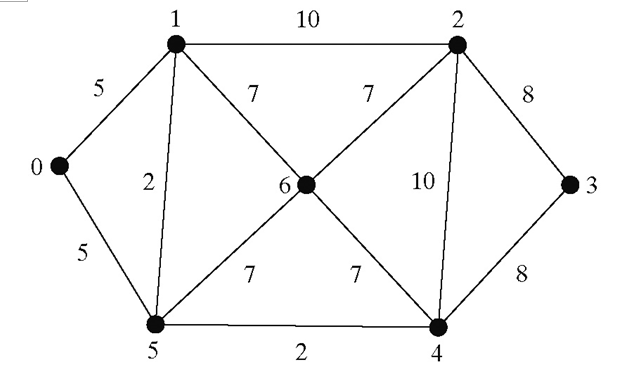Chapter 29 Check Point Questions
Section 29.2
▼29.2.1
For the code WeightedEdge edge = new WeightedEdge(1, 2, 3.5), what is edge.u, edge.v, and edge.weight?
▼29.2.2
What is the output of the following code?
List<WeightedEdge> list = new ArrayList<>(); list.add(new WeightedEdge(1, 2, 3.5)); list.add(new WeightedEdge(2, 3, 4.5)); WeightedEdge e = java.util.Collections.max(list); System.out.println(e.u); System.out.println(e.v); System.out.println(e.weight);
Section 29.3
▼29.3.1
If a priority queue is used to store weighted edges, what is the output of the following code?
PriorityQueue<WeightedEdge> q = new PriorityQueue<>(); q.offer(new WeightedEdge(1, 2, 3.5)); q.offer(new WeightedEdge(1, 6, 6.5)); q.offer(new WeightedEdge(1, 7, 1.5)); System.out.println(q.poll().weight); System.out.println(q.poll().weight); System.out.println(q.poll().weight);
▼29.3.2
If a priority queue is used to store weighted edges, what is wrong in the following code? Fix it and show the output.
List<PriorityQueue<WeightedEdge>> queues = new ArrayList<>(); queues.get(0).offer(new WeightedEdge(0, 2, 3.5)); queues.get(0).offer(new WeightedEdge(0, 6, 6.5)); queues.get(0).offer(new WeightedEdge(0, 7, 1.5)); queues.get(1).offer(new WeightedEdge(1, 0, 3.5)); queues.get(1).offer(new WeightedEdge(1, 5, 8.5)); queues.get(1).offer(new WeightedEdge(1, 8, 19.5)); System.out.println(queues.get(0).peek() .compareTo(queues.get(1).peek()));
▼29.3.3
Show the output of the following code.
public class Test { public static void main(String[] args) throws Exception { WeightedGraph<Character> graph = new WeightedGraph<>(); graph.addVertex('U'); graph.addVertex('V'); int indexForU = graph.getIndex('U'); int indexForV = graph.getIndex('V'); System.out.println("indexForU is " + indexForU); System.out.println("indexForV is " + indexForV); graph.addEdge(indexForU, indexForV, 2.5); System.out.println("Degree of U is " + graph.getDegree(indexForU)); System.out.println("Degree of V is " + graph.getDegree(indexForV)); System.out.println("Weight of UV is " + graph.getWeight(indexForU, indexForV)); } }
Section 29.4
▼29.4.1
Find a minimum spanning tree for the following graph.


▼29.4.2
Is a minimum spanning tree unique if all edges have different weights?
▼29.4.3
If you use an adjacency matrix to represent weighted edges, what will be the time complexity for Prim's algorithm?
▼29.4.4
What happens to the getMinimumSpanningTree() method in WeightedGraph
if the graph is not connected? Verify your answer by writing a test program
that creates an unconnected graph and invokes the getMinimumSpanningTree() method.
▼29.4.5
Show the output of the following code:
public class Test { public static void main(String[] args) { WeightedGraph<Character> graph = new WeightedGraph<>(); graph.addVertex('U'); graph.addVertex('V'); graph.addVertex('X'); int indexForU = graph.getIndex('U'); int indexForV = graph.getIndex('V'); int indexForX = graph.getIndex('X'); System.out.println("indexForU is " + indexForU); System.out.println("indexForV is " + indexForV); System.out.println("indexForX is " + indexForV); graph.addEdge(indexForU, indexForV, 3.5); graph.addEdge(indexForV, indexForU, 3.5); graph.addEdge(indexForU, indexForX, 2.1); graph.addEdge(indexForX, indexForU, 2.1); graph.addEdge(indexForV, indexForX, 3.1); graph.addEdge(indexForX, indexForV, 3.1); WeightedGraph<Character>.MST mst = graph.getMinimumSpanningTree(); graph.printWeightedEdges(); System.out.println(mst.getTotalWeight()); mst.printTree(); } }
Section 29.5
▼29.5.1
Trace Dijkstra's algorithm for finding shortest paths from Boston to all other cities in Figure 29.1.
▼29.5.2
Is a shortest path between two vertices unique if all edges have different weights?
▼29.5.3
If you use an adjacency matrix to represent weighted edges, what would be the time complexity for Dijkstra's algorithm?
▼29.5.4
What happens to the getShortestPath() method in WeightedGraph
if the source vertex cannot reach all vertieces in the graph?
Verify your answer by writing a test program that creates an
unconnected graph and invoke the getShortestPath() method.
▼29.5.5
If there is no path from vertex v to the source vertex, what will be cost[v]?
▼29.5.6
Assume that the graph is connected; will the getShortestPath method find the shortest paths correctly if lines 159-161 in WeightedGraph are deleted?
▼29.5.7
Show the output of the following code:
public class Test { public static void main(String[] args) { WeightedGraph<Character> graph = new WeightedGraph<>(); graph.addVertex('U'); graph.addVertex('V'); graph.addVertex('X'); int indexForU = graph.getIndex('U'); int indexForV = graph.getIndex('V'); int indexForX = graph.getIndex('X'); System.out.println("indexForU is " + indexForU); System.out.println("indexForV is " + indexForV); System.out.println("indexForX is " + indexForV); graph.addEdge(indexForU, indexForV, 3.5); graph.addEdge(indexForV, indexForU, 3.5); graph.addEdge(indexForU, indexForX, 2.1); graph.addEdge(indexForX, indexForU, 2.1); graph.addEdge(indexForV, indexForX, 3.1); graph.addEdge(indexForX, indexForV, 3.1); WeightedGraph<Character>.ShortestPathTree tree = graph.getShortestPath(1); graph.printWeightedEdges(); tree.printTree(); } }
Section 29.6
▼29.6.1
Why is the tree data field in NineTailModel in Listing 28.13 defined protected?
▼29.6.2
How are the nodes created for the graph in WeightedNineTailModel?
▼29.6.3
How are the edges created for the graph in WeightedNineTailModel?